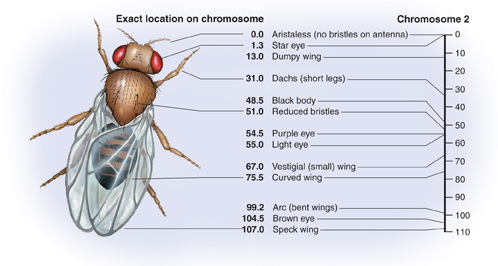Number of Cell Divisions Mitosis is a single cell division, resulting in the production of two identical daughter cells. On the other hand, meiosis requires two rounds of cell division, and, in most organisms, produces a total of four daughter cells.  Mitosis results in the production of two genetically identical diploid cells, whereas meiosis produces four genetically different haploid cells.
Mitosis results in the production of two genetically identical diploid cells, whereas meiosis produces four genetically different haploid cells.
Gene Linkage and Gene Maps
 How can two alleles from different genes be inherited together?
How can two alleles from different genes be inherited together?
If you think carefully about Mendel's principle of independent assortment in relation to meiosis, one question might bother you. Genes that are located on different chromosomes assort independently, but what about genes that are located on the same chromosome? Wouldn't they generally be inherited together?
Gene Linkage The answer to this question, as Thomas Hunt Morgan first realized in 1910, is yes. Morgan's research on fruit flies led him to the principle of gene linkage. After identifying more than 50 Drosophila genes, Morgan discovered that many of them appeared to be “linked” together in ways that, at first glance, seemed to violate the principle of independent assortment. For example, Morgan used a fly with reddish-orange eyes and miniature wings in a series of test crosses. His results showed that the genes for those two traits were almost always inherited together. Only rarely did the genes separate from each other. Morgan and his associates observed so many genes that were inherited together that, before long, they could group all of the fly's genes into four linkage groups. The linkage groups assorted independently, but all of the genes in one group were inherited together. As it turns out, Drosophila has four linkage groups and four pairs of chromosomes.

FIGURE 11–18 Gene Map This gene map shows the location of a variety of genes on chromosome 2 of the fruit fly. The genes are named after the problems that abnormal alleles cause, not after the normal structures. Interpret Graphics Where on the chromosome is the “purple eye” gene located?
d
Table of Contents
- Formulas and Equations
- Applying Formulas and Equations
- Mean, Median, and Mode
- Estimation
- Using Measurements in Calculations
- Effects of Measurement Errors
- Accuracy
- Precision
- Comparing Accuracy and Precision
- Significant Figures
- Calculating With Significant Figures
- Scientific Notation
- Calculating With Scientific Notation
- Dimensional Analysis
- Applying Dimensional Analysis




